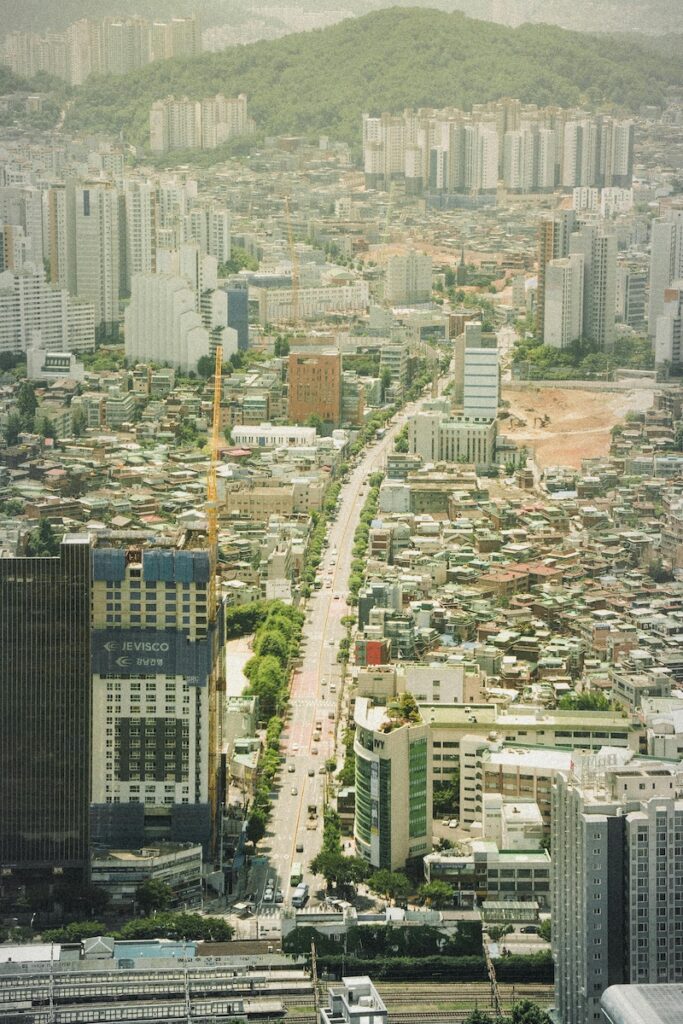If you’re moving to Korea (or leveling up within Seoul), you’ll meet four terms fast: 월세 (wolse), 전세 (jeonse), 반전세 (banjeonse), and 매매 (maemae).
Add in officetel, villa, apartment, a few key documents, and Korea’s very app-first search culture, and you’ve got the essentials.
Think of this as your field guide—what each option really means, when it’s smart, the traps to avoid, and where to look.
1) Lease Types You’ll Actually Use
A. Wolse (Monthly Rent)
What it is:
A small-to-moderate deposit (보증금) + fixed monthly rent. It’s the most familiar to non-Koreans and the most common for studios and small units.
Typical shape:
- Deposit: ₩5–20M for studios (varies widely).
- Monthly: ₩400k–₩1.2M+ depending on area/size/newness.
- Maintenance fee (관리비) is separate—budget another ₩60k–₩200k depending on building and whether heating/internet/parking are included.
Pros: Lower upfront cash, flexible supply, easy to understand.
Cons: Higher ongoing cost; you still need a deposit; check what 관리비 includes (elevator, cleaning, internet, parcel lockers, heating type).
Example:
- Deposit ₩10M + ₩750k/month + 관리비 ₩90k in Mapo (near Hongdae). Total monthly outlay feels like ₩840k.
B. Jeonse (Key-Money Lease)
What it is:
A very large refundable deposit (often 50–80% of the property’s market value) instead of monthly rent. The landlord invests/uses your deposit; you pay near-zero monthly housing cost (you’ll still pay 관리비 and utilities).
Why Koreans like it:
Cash-rich tenants face low monthly burn; landlords get a lump sum.
Pros: Minimal monthly rent; strong tenant rights when properly registered; predictable costs.
Cons: Huge upfront cash; liquidity risk if landlord can’t return the deposit at the end; you must perform safety checks (below).
Example:
- Jeonse deposit ₩300M in Jamsil for a 2-bed apt; monthly rent ₩0; 관리비 ₩200k. Opportunity cost is the foregone interest on ₩300M.
Non-negotiables for jeonse safety:
- 확정일자 (fixed date stamp) at the local 주민센터 on your signed lease.
- 전입신고 (move-in address registration) promptly after you get keys.
- Pull the 등기부등본 (official registry) to confirm ownership and existing loans; compare your deposit to remaining borrowing room.
- Consider 보증보험 (deposit return insurance) if eligible.
Tip: Ask the agent to show the real estate registry printout during the viewing or before 계약금 (contract deposit) payment. Don’t skip this.
C. Banjeonse (Hybrid)
What it is:
Middle ground: larger deposit than wolse, smaller monthly than wolse. Useful if you have some capital but not full jeonse.
Example:
- Deposit ₩120M + ₩300k/month in Seongsu. Same unit on wolse might be ₩20M + ₩800k; on jeonse maybe ₩260M + ₩0.
Pros: Softer monthly burden without the jeonse cash wall.
Cons: You still need significant cash and should do the same registry checks as jeonse.
D. Maemae (Buying)
What it is:
Full purchase. Foreigners can buy residential property in most cases, but mortgage eligibility, LTV limits, taxes, and reporting can differ by status and visa.
Costs to expect:
- Down payment, acquisition tax (취득세), agent fee, registry fees.
- Monthly: 관리비, property tax (and possibly loan payments).
When it makes sense: Long stay horizon, stable income, or if you need a specific school district/new-build complex. For many new arrivals, renting first is simpler.

2) Housing Types (What you’ll actually tour)
Officetel (오피스텔)
What it is:
Mixed-use units (office+residence), often single-room or 1.5-room layouts, newer buildings, great locations near subways/business districts, elevators and parcel lockers, sometimes front desk.
Feels like: Urban studio or junior 1-bed with hotel vibes.
Pros: Central, modern, secure, usually good soundproofing & AC, easy for shorter stays.
Cons: Higher 관리비, smaller kitchens, some units officially “office” (check residential use), parking can be tight.
Best for: Singles/expats who value location and convenience over space.
Villa (빌라) / Low-rise Multiplex (다세대·다가구)
What it is:
3–5 story walk-ups (often no elevator), bigger floor areas for the price, in residential neighborhoods.
Pros: Value per m², separate bedrooms, quieter streets.
Cons: Older stock can mean soundproofing/mold/heating issues; parking is limited; half-basement (반지하) units exist—check moisture/sunlight.
Best for: Budget-minded couples or small families who want more space than an officetel.
Apartment (아파트)
What it is:
High-rise complexes with security, parking, landscaped grounds, playgrounds, often community gyms and on-site management.
Pros: Family-friendly, strong resale/jeonse markets, better insulation, reliable infrastructure.
Cons: Higher costs, competitive markets in good school districts, sometimes strict pet rules.
Best for: Families, long-term residents, anyone prioritizing amenities and school zones.
Other stock you’ll hear about
- One-room / Two-room: Studio vs. 1BR in plain language.
- Goshiwon (고시원): Micro rooms with shared kitchens—ultra budget/short-term.
- Serviced residence: Hotel-like, furnished, pricey but simple.
- Urban lifestyle housing (도시형생활주택): Modern low-rise variants; check exact specs.
3) What Neighborhoods in Seoul Lean Toward Which Homes?
Gangnam-gu (Gangnam/Yeoksam/Samseong/Apgujeong/Cheongdam)
- Lots of officetels around Teheran-ro, premium apartments (Apgujeong/Cheongdam), and newer luxury high-rises.
- Expect higher deposits and rents; great for offices, dining, medical, and transit.
Seocho-gu (Banpo/Seocho/Seocho-dong)
- Big apartment complexes, riverfront redevelopment, schools.
- Family-heavy; strong jeonse and purchase markets.
Songpa-gu (Jamsil/Seokchon/Garak)
- Mega-complex apartments near Lotte World and Olympic Park, with family amenities; also some villas deeper in neighborhoods.
Mapo-gu (Hongdae/Hapjeong/Mapo-dong)
- Officetels + villas dominate; lively streets, cafes, nightlife; great for singles/young couples.
Yongsan-gu (Itaewon/Hannam/Yongsan)
- Mix of embassy-area villas, luxury apartments (Hannam The Hill), and redeveloping officetel zones; international vibe.
Seongdong-gu (Seongsu)
- Trend spot: loft-ish studios, villas, creative-office conversions, rising new apartments; popular with creatives.
Gwangjin-gu (Konkuk Univ/Children’s Grand Park)
- Student-centric one-rooms and officetels, lively food/nightlife at “Kondae”.
Gwanak-gu / Dongjak-gu (Sillim/Seoul Nat’l Univ)
- Budget villas, one-rooms, goshiwons; great value if commute fits.
Jung-gu / Jongno-gu (City Hall/Euljiro/Jongno)
- Central business & heritage core: officetels, some older apartments and villas; convenient but pricier per m².
Nowon / Dobong / Gangbuk
- More affordable apartments and villas, longer commute, good for savings and space.
Satellite picks near Seoul
- Seongnam (Bundang/Pangyo): Newer apts, tech-hub; family-friendly, green spaces.
- Goyang (Ilsan): Planned districts with apartments/parks.
- Hanam / Namyangju / Gimpo: New-town builds, commuter lines, value vs. central Seoul.
4) How to Search (and Not Get Burned)
Where people actually look
- Naver Real Estate (네이버 부동산): The master aggregator to filter by deposit, monthly, size, floor, pet, parking.
- Zigbang (직방), Dabang (다방): App-first experiences with photos, 3D/VR in many listings.
- Peter Pan’s Good Room (피터팬): More direct-from-owner vibe (varies).
- Local 공인중개사 (“budongsan”): The neighborhood agent who knows which units are real/available today.
Pro move: Shortlist online, then walk the block—you’ll see clusters of 공인중개사. Step in, show 2–3 examples on your phone, and ask for live, verified options. This cuts fake/expired listings.
Documents you’ll need
- Passport + ARC (외국인등록증)
- Korean phone number & bank account (for payments and utility setup)
- Employment letter or income proof (some landlords ask)
- If company-sponsored: Business registration certificate from employer for corporate leases
The 3-step payment rhythm
- 계약금 (contract deposit): usually ~10% to hold the unit.
- 중도금 (interim): sometimes used, especially for jeonse or larger deals.
- 잔금 (balance): on key handover day.
Always: Check the registry (등기부등본), get 확정일자, file 전입신고 fast.
Commission & fees (ballparks)
- Agent fee (중개수수료): Sliding scale by rent/sale price; capped by regulation. Expect ~0.3–0.8% for typical leases/sales (ask the agent the exact band).
- Stamp/tax: Minimal for leases, more for purchases.
- Key money transfer: Bank transfer day-of; bring your passport/ARC.
5) What to Inspect at the Viewing (Checklist)
- Moisture & mold: Window frames, bathrooms, behind furniture, under sinks.
- Orientation (향) & daylight: South/east get better winter sun; north can be dim/cold.
- Heating: Individual gas boiler vs. district heating; test hot water & floor heat (온돌).
- Noise: Upstairs footsteps? Road/rail noise? Officetels are usually quieter than villas.
- Water pressure & drainage: Shower and kitchen sink test.
- Windows & doors: Drafts? Broken seals?
- Appliances: Fridge/washer/AC included? Condition?
- Mobile/data: 5G/Wi-Fi speeds; internet provider options.
- Parking/EV charging: If you drive.
- Pet policy: Strict in many apartments—get it in writing.
- Fire safety: Sprinklers, extinguishers, escape ladders in older villas.
Before paying 계약금, ask the agent to message the current outstanding loan balance on the property (from registry). If your jeonse deposit + existing mortgage looks too tight against property value, walk away or require deposit insurance.
6) Monthly Costs Most People Forget
- 관리비 (maintenance): Lobby/security/elevators/cleaning, sometimes internet/heating/parking. Large apartments and officetels can run ₩100k–₩300k+.
- Utilities:
- Gas (cooking/heating): seasonal swings (winter can spike).
- Electricity: AC in summer; watch tiered pricing.
- Water/sewage: minor but present.
- Internet/IPTV: ₩25k–₩40k typical bundles.
- Home insurance: Cheap add-on; consider for peace of mind.
- Move-in cleaning/painting: Negotiate with landlord if condition is rough.
7) Choosing Among Wolse, Jeonse, Banjeonse (Decision Frames)
Pick wolse if…
- You’ll stay < 2–3 years.
- You don’t have, or don’t want to tie up, big capital.
- You want a newer/officetel in a prime location.
Pick jeonse if…
- You have significant cash (or a jeonse loan via employer bank package).
- You’re staying long and want low monthly outlay.
- You’re comfortable doing proper legal checks (or using deposit insurance).
Pick banjeonse if…
- You can post a meaningful deposit but not full jeonse.
- You want to lower monthly without going all-in.
Buying
- Great if you’ll settle and care about school district or capital build-up—but understand tax/financing differences and holding costs.

8) Trend Watch: Platforms, Data, and “Seeing Before You See”
- App-first: Most locals filter by deposit/monthly/floor plan/age then message in-app.
- 3D & video tours: Many listings include VR walkthroughs—helpful for screening.
- Real price data (실거래가): Government-published actual transaction prices exist; use them to benchmark (agents can show you).
- Digital contracts: Growing but still mixed; traditional paper + seal is common; either works if registry/confirmations are right.
9) Micro-Examples (So you can “feel” the numbers)
- Officetel (Mapo-gu, 24m², 8-year old)
- Wolse: ₩10M deposit + ₩900k/month + 관리비 ₩110k
- Banjeonse: ₩80M deposit + ₩350k/month + 관리비 ₩110k
- Jeonse: ₩180M + 관리비 ₩110k
- Villa (Seongdong-gu, 48m², 2BR, 15-year old)
- Wolse: ₩20M + ₩850k + 관리비 ₩50k
- Banjeonse: ₩120M + ₩300k + 관리비 ₩50k
- Jeonse: ₩250M + 관리비 ₩50k
- Apartment (Songpa-gu, 59m², family-oriented complex)
- Wolse: Rare but e.g., ₩50M + ₩1.8M + 관리비 ₩200k
- Jeonse: ₩450–600M + 관리비 ₩200k
(Illustrative only; markets move by season, rates, and building.)
10) Etiquette & “Koreanisms” That Help
- Use both hands for documents, keys, and bankbooks—polite goes far.
- Line messaging groups with your agent/landlord are common—keep comms clear.
- Move-in condition report (하자 리스트): Take timestamped photos on Day 1 and share; avoids disputes on move-out.
- Trash & recycling: Seoul is strict; ask for the designated bags and rules (food waste is separate).
- Building rules: Quiet hours, parcel lockers, bike storage—ask the guard or management office.
11) Quick Step-by-Step (From Search to Keys)
- Filter (district/budget/size/pet/parking) on Naver Real Estate / Zigbang / Dabang.
- Tour in person with a local 공인중개사; verify registry before 계약금.
- Contract: Clear deposit, monthly, inclusions, move-in date, special terms (pets, repaint).
- Pay 계약금, then 잔금 on handover day.
- Visit 주민센터 for 확정일자 on the lease and 전입신고.
- Set up gas/electric/water/internet.
- Submit 하자 리스트 within a few days.
Do those seven steps, and you’re 90% ahead of horror stories.
12) TL;DR Matching Matrix
Priority Best Fit Why
| Lowest monthly | Jeonse | Big deposit, tiny monthly |
| Lowest upfront | Wolse | Small deposit, pay as you go |
| Balanced cashflow | Banjeonse | Reduced monthly for mid deposit |
| Central, modern | Officetel | Location + amenities |
| Space per ₩ | Villa | Larger layouts, lower price |
| Family amenities | Apartment | Schools, parks, services |
Final Thoughts
Korean housing is different—but logical. If you learn the three rental structures (wolse/jeonse/banjeonse), the main product types (officetel/villa/apartment), and the must-do protections (registry check → 확정일자 → 전입신고), you’ll navigate like a local.
Start with the neighborhood vibe that fits you—Mapo for creative energy, Songpa for family life, Gangnam/Seongdong for business-plus-play—and use the apps + street-level agents together.
Whether you aim for flexible wolse, capital-efficient banjeonse, or classic jeonse, Korea’s market has a lane for you.
If you want, I can reshape this into a downloadable checklist (PDF): viewing checklist, fee calculator, and a Seoul district cheat-sheet. Just say the word.

